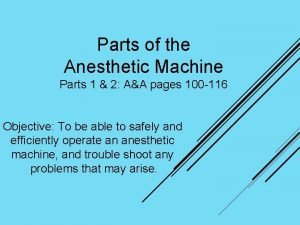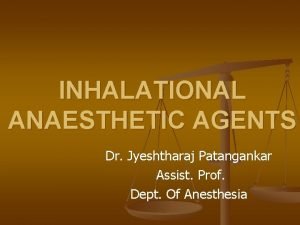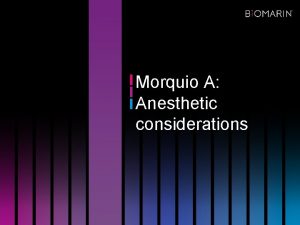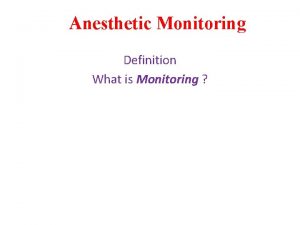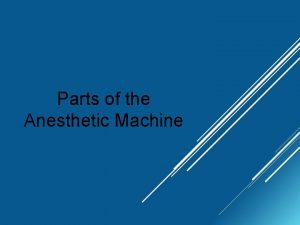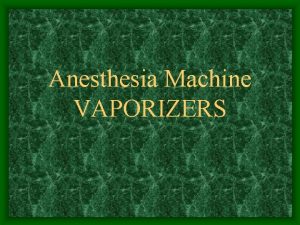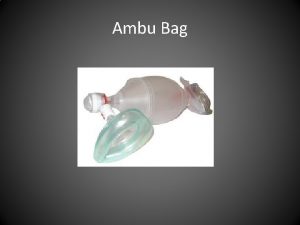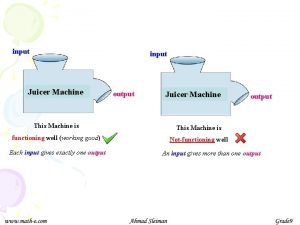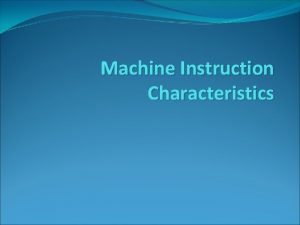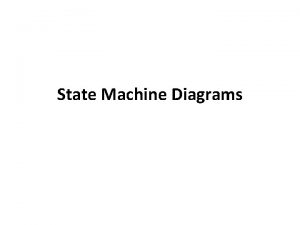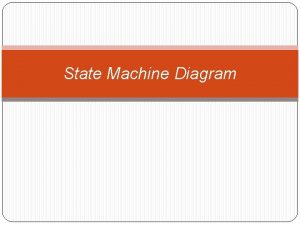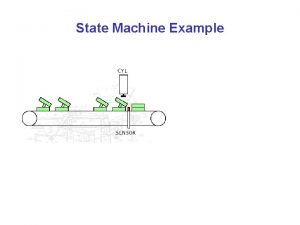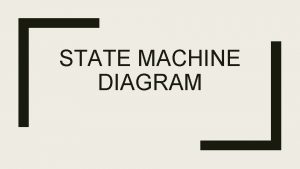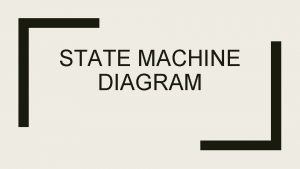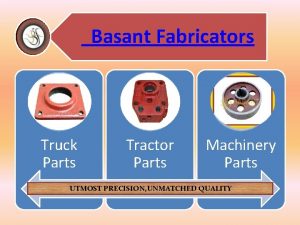Parts of the Anesthetic Machine Parts 1 2




































- Slides: 36

Parts of the Anesthetic Machine Parts 1 & 2: A&A pages 100 -116 Objective: To be able to safely and efficiently operate an anesthetic machine, and trouble shoot any problems that may arise.

Purpose of the Anesthetic Machine A _____ inhalant anesthetic is _______ into a carrier gas, and precisely delivered to the patient via a breathing circuit. 1. Maintains general _________. Inhalant • Expressed as a __________ Carrier • anesthetic is delivered at a precise rate gas is delivered at a controlled rate Measured in __________ 2. Used to deliver pure oxygen Good for during recovery or in an emergency

Parts of the Anesthetic Machine 1. Compressed gas supply 2. Anesthetic vaporizer 3. Breathing system 4. Scavenging System

PART 1: Compressed Gas Supply Compressed Tank gas cylinder/tank pressure gauge Pressure reducing valve Line pressure gauge Flow meter Oxygen flush valve

Compressed Gas Cylinders Most commonly used carrier gas is ______. It comes compressed in a metal cylinder and held under pressure- up to _______ psi! Tanks are delivered and picked up by the oxygen supply company as needed

Compressed Gas Cylinders Available in various sizes: E tanks/cylinders, attach to the anesthetic machine via a ____.

Compressed Gas Cylinders H tanks/cylinders can hook up to anesthesia machines directly But they are usually stored in a central gas supply room

Compressed Gas Cylinders Tanks are color coded for safety and recognition § Oxygen tanks: ______ § Nitrous oxide tanks: _____ § Carbon dioxide tanks: ____ *not used for anesthesia

Gas Cylinders- Safety Yokes are gas-specific Ex. The valve on the oxygen tank matches the ___________ on a yoke that is specific to oxygen An oxygen yoke has two pins below the outlet port

Gas Cylinders- Safety Combustible Tanks If • gases- avoid flames and sparks! must be stored in a secure location dropped, has the potential to act as a torpedo Never leave a cylinder unattended!

Tank Pressure Gauge Displays • the pressure of gas currently in the tank. Measures in ____. Displays a reading once the tank is opened. To open tank: use built in lever OR use the _______ § Only open once tank has been connected to a yoke! OR Your tank should be opened first thing in the morning so it is ready to go!

Tank Pressure Gauge

Tank Pressure Gauge Readings Gauge reads the current PSI when the tank is open Gauge STILL reads the current PSI when the tank is then closed Gauge reads zero when the tank has been closed and the lines have been flushed **Ensure the gas cylinder has oxygen BEFORE starting every anesthetic procedure**

When Should You Change the Tank? Refill line is at 500 psi VTI rule: Math can help you to estimate when your tank will become empty!

Figuring Out the Amount of Time Left in the Tank 1. Calculate how many liters of oxygen you have. Multiply the pressure (psi) by a magic number: ____ for E tanks and _____ for H tanks Example:

Pressure Reducing Valve aka Pressure Regulator Regulates the pressure of the gas leaving the tank Reduces the pressure of oxygen from 2200 psi to a safer _____ psi. Can be measured with a ___________ Know what line we are measuring the pressure in

Flow Meter 1. Allows the _______ of oxygen traveling through the machine to be adjusted by the anesthetist. *Measured in __________ § Ball rises in height, proportional to gas flow • § § Read at the center of the ball Oxygen does not start flowing to the patient unless this is turned on! What can you set the flow meter to?

Flow Meter 2. Reduces the psi AGAIN: to ______. BE GENTLE WITH THE KNOB, DO NOT OVERTIGHTEN!

Oxygen Flow Rates Based on how we are supplying the gas: Mask induction: _______ L/min Induction chamber: _____ L/min *NOTE: The anesthetic agent will be set to the maximum amount any time you are inducing anesthesia with an inhalant! Maintenance through an endotracheal tube: __________________

Amount of Time Left in the Tank (cont. ) We already figured out the # of liters of oxygen in the tank from Step 1 in the previous example. Step 2. Divide that amount by the flow rate you’re using: Ex: What if we change the flow rate?

PRACTICE: Calculate Time of Tank Use Left Ex: If you have a full E tank (2200 psi) and a flow rate of 2 L/min: Ex: If you have a full H tank (2200 psi) and a flow rate of 1. 5 L/min:

Oxygen Flush Valve Rapidly delivers pure, 100% oxygen at a high, variable flow rate of ______ and a pressure of _______. o Pure O 2 because: o High pressure/rate because: *O 2 goes directly from pressure reducing valve breathing system lungs Ideally, should not be depressed while connected to the patient

Oxygen Flush Valve Seems dangerous…when would we ever use this? 1. To ______ anesthetic in circuit If using connected to the patient, watch the manometer!

Oxygen Flush Valve What is a better alternative to pressing this button?

PART 2: Anesthetic Vaporizer The next stop as oxygen travels from the flow meter Vaporizer inlet port Dial Safety lock Indicator Fill window port Vaporizer outlet port

Vaporizer Carrier gas enters through the vaporizer _______ Converts the liquid anesthetic agent into a vapor Adds a controlled amount of these vapors to the carrier gas, making ________. The vaporizer must be on to deliver any inhalant anesthetics to the patient § Must press down on _______ to turn dial on § What about to turn off? *The flow meter must be on to supply the oxygen!

Vaporizer Should be full before beginning any anesthetic procedure. Amount of anesthetic liquid in the vaporizer is visible in the _____________. Only fill to the bottom of the “FULL” letters 1. Make sure vaporizer is OFF 2. Unscrew cap of fill port and pour liquid in, watching the indicator window THE ENTIRE TIME 3. Replace cap immediately § DO NOT OVER FILL

Vaporizer Use the correct anesthetic for the vaporizer! (Isoflurane vs. Sevoflurane) Matching Do anti-spill devices not throw away!!

Vaporizer Safety If the vaporizer is tipped over (usually the whole machine), shaken, OR overfilled: § Lethal doses of inhalant are spilled into outlet port hoses § Ensure vaporizer is off and _____ anesthetic agent § Run oxygen only through the machine for ______ to flush it out. § Must be done in a well ventilated area, away from personnel Should be done before transporting machine!

Flow of Carrier Gas through Vaporizer

Vaporizer Fresh gas leaves through the vaporizer_______ port The outlet port either leads to a free hanging hose, OR a hose which goes into the machine and comes out the front OR Common/Fresh Gas Outlet

Precision Vaporizer Deliver a _____, ______ amount of anesthetic drug to the patient Expressed • as a ______ which is chosen based on the: Anesthetic agent AND • Patient’s requirement Use the dial to set the amount of drug you want the animal to receive

Old School Vaporizers Non-precision vaporizers are simple, cheaper, and are typically used for inhalant anesthetics with _______________. Non-precision vaporizers are located within the breathing circuit • Gas flows from the flow meter into the breathing tubes, which contain the vaporizer. *They are no longer used; we will focus on precision vaporizers.

Non-precision Vaporizer

Non-precision Vaporizers Outside factors can affect the concentration of anesthetic delivered 1. _______ changes Inhalant anesthetics vaporize more rapidly at high temperatures hot environment = higher anesthetic output

Non-precision Vaporizers 2. Flow rate and respiratory rate of patient effect the amount of anesthetic drug delivered 3. Increased pressure in the circuit exerts pressure on the vaporizer outlet port
 Anesthesia machine parts
Anesthesia machine parts Anesthetic, pungent, sweet
Anesthetic, pungent, sweet Hình ảnh bộ gõ cơ thể búng tay
Hình ảnh bộ gõ cơ thể búng tay Lp html
Lp html Bổ thể
Bổ thể Tỉ lệ cơ thể trẻ em
Tỉ lệ cơ thể trẻ em Gấu đi như thế nào
Gấu đi như thế nào Tư thế worms-breton
Tư thế worms-breton Bài hát chúa yêu trần thế alleluia
Bài hát chúa yêu trần thế alleluia Các môn thể thao bắt đầu bằng tiếng bóng
Các môn thể thao bắt đầu bằng tiếng bóng Thế nào là hệ số cao nhất
Thế nào là hệ số cao nhất Các châu lục và đại dương trên thế giới
Các châu lục và đại dương trên thế giới Cong thức tính động năng
Cong thức tính động năng Trời xanh đây là của chúng ta thể thơ
Trời xanh đây là của chúng ta thể thơ Mật thư tọa độ 5x5
Mật thư tọa độ 5x5 101012 bằng
101012 bằng Phản ứng thế ankan
Phản ứng thế ankan Các châu lục và đại dương trên thế giới
Các châu lục và đại dương trên thế giới Thơ thất ngôn tứ tuyệt đường luật
Thơ thất ngôn tứ tuyệt đường luật Quá trình desamine hóa có thể tạo ra
Quá trình desamine hóa có thể tạo ra Một số thể thơ truyền thống
Một số thể thơ truyền thống Cái miệng nó xinh thế chỉ nói điều hay thôi
Cái miệng nó xinh thế chỉ nói điều hay thôi Vẽ hình chiếu vuông góc của vật thể sau
Vẽ hình chiếu vuông góc của vật thể sau Thế nào là sự mỏi cơ
Thế nào là sự mỏi cơ đặc điểm cơ thể của người tối cổ
đặc điểm cơ thể của người tối cổ V. c c
V. c c Vẽ hình chiếu đứng bằng cạnh của vật thể
Vẽ hình chiếu đứng bằng cạnh của vật thể Tia chieu sa te
Tia chieu sa te Thẻ vin
Thẻ vin đại từ thay thế
đại từ thay thế điện thế nghỉ
điện thế nghỉ Tư thế ngồi viết
Tư thế ngồi viết Diễn thế sinh thái là
Diễn thế sinh thái là Các loại đột biến cấu trúc nhiễm sắc thể
Các loại đột biến cấu trúc nhiễm sắc thể Bảng số nguyên tố
Bảng số nguyên tố Tư thế ngồi viết
Tư thế ngồi viết Lời thề hippocrates
Lời thề hippocrates
